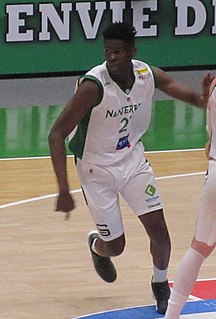
Herring are forage fish, mostly belonging to the family Clupeidae.

Myosotis is a genus of flowering plants in the family Boraginaceae. The name comes from the Ancient Greek μυοσωτίς "mouse's ear", which the foliage is thought to resemble. In the northern hemisphere they are colloquially denominated forget-me-nots or scorpion grasses. The colloquial name "forget-me-not" was calqued from the German Vergissmeinnicht and first used in English in AD 1398 through King Henry IV of England. Similar names and variations are found in many languages. Myosotis alpestris is the official flower of Alaska and Dalsland, Sweden. Plants of the genus are commonly confused with Chatham Islands' forget-me-nots which belong to the related genus Myosotidium.
The leaf muntjac, leaf deer or Putao muntjac is a small species of muntjac. It was documented in 1997 by biologist Alan Rabinowitz during his field study in the isolated Naungmung Township in Myanmar. Rabinowitz discovered the species by examining the small carcass of a deer that he initially believed was the juvenile of another species; however, it proved to be the carcass of an adult female. He managed to obtain specimens, from which DNA analysis revealed a new cervid species. Local hunters knew of the species and called it the leaf deer because its body could be completely wrapped by a single large leaf. It is found in Myanmar and India.

Aphantophryne is a genus of microhylid frogs found in New Guinea and in Mindanao, the Philippines. Originally described by Fry in 1917, Richard G. Zweifel considered in 1956 Aphantophryne synonymous to Cophixalus. The genus was resurrected in 1989 to house two new species in addition to the type species, A. pansa. A molecular study on the subfamily Asterophryinae in 2017 revealed that two species originally included in the genus Oreophryne were more closely related to Aphantophryne than to other Oreophryne, and were consequently moved to this genus. The study also revealed a number of undescribed species.

A near-threatened species is a species which has been categorized as "Near Threatened" (NT) by the International Union for Conservation of Nature as that may be vulnerable to endangerment in the near future, but it does not currently qualify for the threatened status.
The Cypriot mouse is a species of mouse endemic to Cyprus. Its primary habitat seems to be the vineyards and fields of the Troödos Mountains region.

A species that is extinct in the wild (EW) is one that has been categorized by the International Union for Conservation of Nature as known only by living members kept in captivity or as a naturalized population outside its historic range due to massive habitat loss.

Aphantophryne minuta is a species of frog in the family Microhylidae. It is endemic to Papua New Guinea and is known from its type locality near Myola Guest House in the Owen Stanley Range, Northern Province, from another locality in the same province, Mount Tafa; only a single specimen is known from each locality. The specific name minuta refers to the very small size of this species. Common name Myola Guinea frog has been coined for it.

Aphantophryne sabini is a species of frog in the family Microhylidae. It is endemic to Papua New Guinea and is only known from the region of its type locality, Myola Guest House in the Owen Stanley Range, Northern Province. The specific name sabini honors Andrew E. Sabin, an American businessman, philanthropist, and environmentalist who joined the expedition during which the holotype of this species was collected. However, its vernacular name Guest House Guinea frog refers to the type locality instead.
Cophixalus verecundus is a species of frog in the family Microhylidae. It is endemic to New Guinea in Papua New Guinea, where it is only known around Mt. Bellamy in Owen Stanley Mountains though it may more widely distributed.

Aphantophryne nana is a species of frog in the family Microhylidae. It is endemic to the Philippines and is known with certainty only from the island of Camiguin. It is unclear whether similar frogs from northeast Mindanao are referable to this species. It was described as Oreophryne nana, but based on molecular data it was moved to Aphantophryne in 2017. Common names Camiguin cross frog, Camiguin narrow-mouthed frog, and volcano cross frog have been coined for the species.
Aphantophryne parkeri is a species of frog in the family Microhylidae. It is endemic to the north coast of New Guinea and only known from Matapan and the Bewani Mountains in the West Sepik Province, Papua New Guinea, and from Sentani in the Papua Province, Western New Guinea (Indonesia). This species was formerly included in the genus Oreophryne, but was in 2017 moved to Aphantophryne based on molecular data. The specific name parkeri honours Hampton Wildman Parker, an English zoologist and herpetologist. Common name Parker's cross frog has been coined for it.
Plicopurpura pansa is a species of sea snail, a marine gastropod mollusk in the family Muricidae, the murex snails or rock snails.

Plicopurpura is a genus of sea snails, marine gastropod mollusks in the family Muricidae, the murex snails or rock snails.

Pansa Hemviboon is a Thai professional footballer who plays as a centre back for Thai League 1 club Buriram United and the Thailand national team.

Jean-Marc Pansa is a French professional basketball player for Antibes Sharks of the LNB Pro B. Standing at 2.08 m, Pansa plays as center.
PANSA is the Polish Air Navigation Services Agency.

Giampaolo Pansa was an Italian journalist-commentator and, especially during his later years, a prolific author of books and essays. Much of his writing was rooted in recent or contemporary history, notably with regard to the antifascist resistance of the Mussolini years.









